Marcarius was the Duke of Friuli from 776 to 787. He was the first Friulian duke appointed by Charlemagne after the rebellion of the Lombard Hrodgaud. [1] He was probably not a Lombard. He played a minor part in the Schism of the Three Chapters.
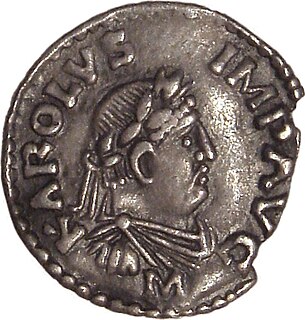
Charlemagne or Charles the Great, numbered Charles I, was King of the Franks from 768, King of the Lombards from 774, and Holy Roman Emperor from 800. He united much of western and central Europe during the Early Middle Ages. He was the first recognised emperor to rule from western Europe since the fall of the Western Roman Empire three centuries earlier. The expanded Frankish state that Charlemagne founded is called the Carolingian Empire. He was later canonized by Antipope Paschal III.
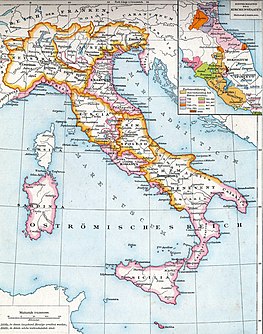
The Lombards or Longobards were a Germanic people who ruled most of the Italian Peninsula from 568 to 774.
Hrodgaud or Rodgand was the Duke of Friuli from 774 to 776. In all likelihood he was already duke under Desiderius, notwithstanding some Frankish sources, such as the Einhardis annales, who say that Charlemagne put him in power after the Siege of Pavia.
When the bishop of Istria, Maurice, was arrested and his eyes gouged out by the Byzantine authorities for allegedly stirring up the populace to desert Byzantium for the Frankish Empire, Pope Hadrian I received him in Rome before sending him to the court of Marcarius in Friuli. Hadrian also sent a letter to Charlemagne asking him to send Marcarius against Byzantine Istria to reinstall Maurice in his see. [2]
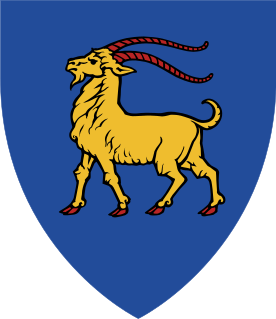
Istria, formerly Histria (Latin), Ίστρια, is the largest peninsula in the Adriatic Sea. The peninsula is located at the head of the Adriatic between the Gulf of Trieste and the Kvarner Gulf. It is shared by three countries: Croatia, Slovenia, and Italy. Croatia encapsulates most of the Istrian peninsula with its Istria County.

The Byzantine Empire, also referred to as the Eastern Roman Empire or Byzantium, was the continuation of the Roman Empire in its eastern provinces during Late Antiquity and the Middle Ages, when its capital city was Constantinople. It survived the fragmentation and fall of the Western Roman Empire in the 5th century AD and continued to exist for an additional thousand years until it fell to the Ottoman Turks in 1453. During most of its existence, the empire was the most powerful economic, cultural, and military force in Europe. Both the terms "Byzantine Empire" and "Eastern Roman Empire" are historiographical terms created after the end of the realm; its citizens continued to refer to their empire simply as the Roman Empire, or Romania (Ῥωμανία), and to themselves as "Romans".

Pope Adrian I was Pope from 1 February 772 to his death in 795. He was the son of Theodore, a Roman nobleman.
Marcarius was succeeded by Eric, a faithful of Charlemagne. [1]
Eric was the Duke of Friuli from 789 to his death. He was the eldest son of Gerold of Vinzgouw and by the marriage of his sister Hildegard the brother-in-law of Charlemagne.
The 770s decade ran from January 1, 770, to December 31, 779.

Year 774 (DCCLXXIV) was a common year starting on Saturday of the Julian calendar. The denomination 774 for this year has been used since the early medieval period, when the Anno Domini calendar era became the prevalent method in Europe for naming years.

Year 776 (DCCLXXVI) was a leap year starting on Monday of the Julian calendar. The denomination 776 for this year has been used since the early medieval period, when the Anno Domini calendar era became the prevalent method in Europe for naming years.

Year 610 (DCX) was a common year starting on Thursday of the Julian calendar. The denomination 610 for this year has been used since the early medieval period, when the Anno Domini calendar era became the prevalent method in Europe for naming years.

Aistulf was the Duke of Friuli from 744, King of Lombards from 749, and Duke of Spoleto from 751. His father was the Duke Pemmo.
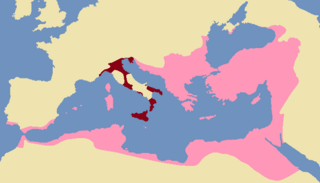
The Exarchate of Ravenna or of Italy was a lordship of the Byzantine Empire in Italy, from 584 to 751, when the last exarch was put to death by the Lombards. It was one of two exarchates established following the western reconquests under Emperor Justinian to more effectively administrate the territories, along with the Exarchate of Africa.
Pepin or Pippin, born Carloman, was the son of Charlemagne and King of the Lombards (781–810) under the authority of his father.

The Duchy of Benevento was the southernmost Lombard duchy in the Italian peninsula, centered on Benevento, a city in Southern Italy. Being cut off from the rest of the Lombard possessions by the papal Duchy of Rome, Benevento was practically independent from the start. Only during the reigns of Grimoald, King of the Lombards and the kings from Liutprand on was the duchy closely tied to the kingdom. After the fall of the kingdom, however, alone of Lombard territories it remained as a rump state, and maintained its de facto independence for nearly three hundred years, though it was divided after 849.
Romanus was Exarch of Ravenna (589-596/7).
Hildeprand, sometimes called the Useless, was the king of the Lombards from around 735 in association with his uncle, Liutprand. After Liutprand's death in 744, Hildeprand ruled in his own name until he was overthrown later that year by Ratchis, duke of Friuli.

Arechis II was a Duke of Benevento, in Southern Italy. He sought to expand the Beneventos' influence into areas of Italy that were still under Byzantine control, but he also had to defend against Charlemagne, who had conquered northern Italy.
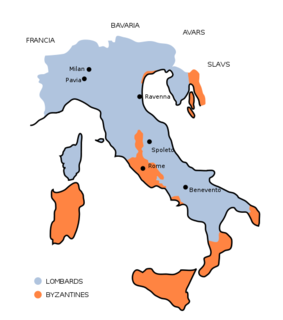
The Kingdom of the Lombards also known as the Lombard Kingdom; later the Kingdom of (all) Italy, was an early medieval state established by the Lombards, a Germanic people, on the Italian Peninsula in the latter part of the 6th century. The king was traditionally elected by the highest-ranking aristocrats, the dukes, as several attempts to establish a hereditary dynasty failed. The kingdom was subdivided into a varying number of duchies, ruled by semi-autonomous dukes, which were in turn subdivided into gastaldates at the municipal level. The capital of the kingdom and the center of its political life was Pavia in the modern northern Italian region of Lombardy.

The Duchy of Friuli was a Lombard duchy in present-day Friuli, the first to be established after the conquest of the Italian peninsula in 568. It was one of the largest domains in Langobardia Major and an important buffer between the Lombard kingdom and the Slavs, Avars, and the Byzantine Empire. The original chief city in the province was Roman Aquileia, but the Lombard capital of Friuli was Forum Julii, modern Cividale.
Hildeprand was the Duke of Spoleto from 774 to 789.
Winiges was the Duke of Spoleto from 789 to his death. He was probably a Lombard in the entourage of Charlemagne when he was sent in 788 to lead Hildeprand of Spoleto and Grimoald III of Benevento in cooperation with Frankish troops against a Byzantine invasion.
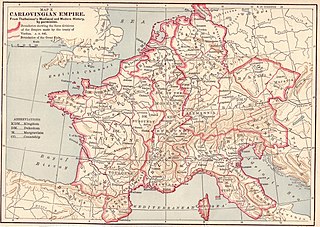
The March of Friuli was a Carolingian frontier march, established in 776 as the continuation of the Lombard Duchy of Friuli, established against the Slavs and Avars.
It was ceded to the Duchy of Bavaria as the March of Verona in 952.
Its territory comprised the parts of modern-day Italy, Slovenia and Croatia.
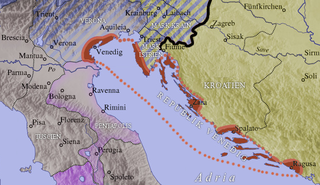
The March of Istria was originally a Carolingian frontier march covering the Istrian peninsula and surrounding territory conquered by Charlemagne's son Pepin of Italy in 789. After 1364, it was the name of the Istrian province of the Habsburg Monarchy, the Austrian Empire and Austria-Hungary.
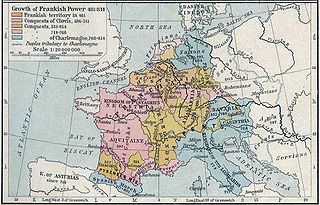
The Siege of Trsat was a battle fought over possession of the town of Trsat in Liburnia, near the Croatian–Frankish border. The battle was fought in the autumn of 799 between the defending forces of the Dalmatian Croatia under the leadership of Croatian duke Višeslav and the invading Frankish army of the Carolingian Empire led by Eric of Friuli. The battle was a Croatian victory, and the Frankish commander Eric was killed during the siege.

















